
Idle Theory: outline
|
We have, over the past 400 years, developed an extraordinarily
powerful body of scientific knowledge - but without any corresponding
development in political, economic, and ethical understanding. The result has been that almost all our most intractable problems
are political, economic, and ethical in nature. The success of modern science has prompted any number of attempts to extend the methods of science to these problems. Most of these attempts have failed.
Idle Theory takes a new look at this old problem. Using a simple physical model of life, it first explores biology, and evolution, and then extends into human economics, ethics, and politics. In Idle Theory, all forms of life are regarded as alternating between periods when they actively work to maintain themselves, and periods when they are idle or inactive. The most idle forms of life, that do the least work, are those most likely to survive crises during which more work needs to be done. Human life is another form of idle life. The history of human society, human technology, trade and law, is one long attempt to increase human idleness. Humans are free to act as they like to the extent they are idle: they are part-time free agents. All human culture - art, music, poetry, literature - is the product of idle time. |
1. Idle Life.
Just as iron rusts, and wood rots, and stones split apart, so also living creatures are subject to continual decay. What distinguishes life from non-life is that living creatures actively repair themselves. This self-maintenance entails physical work, just as a house-owner physically works to replace the broken tiles and rotted timbers in his house. Performing physical work entails an expenditure of energy.
Living creatures continuously expend energy repairing themselves. They also expend additional energy in growing and reproducing. In order to meet these energy needs, they must acquire energy from their environment. Plants capture the radiant energy of the sun, and grazing animals feed from the energy stored in plants, and predators in turn feed on the energy stored in grazing animals. If they are unable to acquire sufficient energy, their energy stores dwindle, and they become unable to maintain and repair themselves, and they die.
Although energy expenditure is continuous, energy acquisition is not continuous. Most grazing animals, and their predators, spend relatively small amounts of time feeding. Plants are only able to capture radiant energy during daylight hours. The energy captured during this relatively short period of energy is stored for later use, as starch in plants, as fat in animals.
Thus every and any kind of living creature is regarded as alternating between two states: either busy acquiring energy, or idle. The fraction of time that a creature is idle is termed its Idleness, and ranges between 0% and 100%.
Several animations illustrate the alternation between the two states. A simple grazer, composed of a energy store and mouth, feeds in a field. The grazer's energy store is continually being used to power the repair and replacement of the grazer's component parts. The grazer starts feeding when its store is nearly empty, and stops when it is full. After it has refilled itself, this store of fuel dwindles away as it is used to power maintenance. The cycle repeats indefinitely.
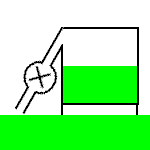 |
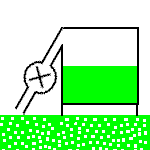 |
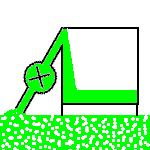 |
|
1. idleness=66% In the first field, where the grass grows thickest , the grazer spends one third of its time actively feeding, and the remaining two thirds idle. |
2. idleness=33% In the second field, clumps of grass are dispersed more widely than in the first field. Consequently the grazer has to work twice as hard, and spends two thirds of its time feeding. The duration of its feeding cycle doubles. |
3. idleness=0% In the third field, clumps of grass are even more thin on the ground, and the grazer spends its entire time feeding, without managing to increase its store of energy at all in the process. It acquires energy at the same rate that it expends it. |
Zero idleness (Case 3) represents a threshold state. If the grass energy content were to fall further, the grazer would find, even feeding non-stop, that its store of energy gradually emptied. Once empty, both repair and feeding stop, as there is no energy to power these activities. At this point the grazer dies.
In Idle Theory, 0% or zero idleness is the threshold of death. And passing through this threshold is the only way any creature dies. If a grazer is damaged, so that fuel leaks out of its store, the result is a decrease in idleness, which may drive it through the threshold. Being crushed by a falling stone is simply an extreme case of damage. If the grazer becomes infested by parasites which feed off its energy store, the result is a decrease in idleness. Being attacked by a large predator is simply an extreme case of parasitism. And since becoming aged entails a general weakening, it takes longer for a creature to find and consume food - and that means falling idleness.
Idle Theory is supposes that nature throws up a variety of different lifeforms, each of which, in the same environment, has different idleness. Thus in one environment, creature A would be 50% idle, creature B 80% idle, creature C 20% idle, and so on. If, from whatever cause, the environment became less rich in energy, all the creatures would have to work harder, and the idleness of each would fall. Creature A would then become, say, 40% idle, creature B 70% idle, and creature C 10% idle, and so on. And as environmental energy continued to fall, the least idle of the creatures, in this case creature C, would pass through the zero idleness threshold of death before the most idle, creature B. The result would be a differential mortality, the least idle dying, the most idle surviving. If it is taken that the energy density, or richness in available energy, of natural environments regularly fluctuates, then there will be regular episodes during which the least idle of the extant creatures die, while the remainder live on. Thus a form of natural selection operates, which rewards the most idle creatures with continuing life, and punishes the busiest with death. Nature, therefore, sets a premium on the highest idleness.
2. The Survival of the Idlest.
Idle Theory begins by considering simple theoretical "cells" that grow and reproduce, so that from one original cell, a population of cells arises. The cells also occasionally produce variants, so that any population of cells contains a number of sub-populations of variant cell types. In the same environment, the idleness of different cell types differs.
In one simple model, the cells reproduce in a pool of nutrients, which is constantly being fed by a trickle of nutrients. As the cells multiply, and consume the nutrients in the pool, the density of nutrients in the pool falls. As nutrient density falls, cell idleness falls, as cells have to work harder to find nutrients. When cells encounter the zero idleness threshold, they begin dying, and the cell population crashes. With few cells remaining, the trickle-fed pool nutrient density then begins to rise, and continues to do so until the cell population recovers enough to start reducing the nutrient density again, repeating the process. In this Malthusian model the creatures themselves generate repeated falls in the environmental energy density, and natural selection does not wait for changes in the environment arising from external causes.
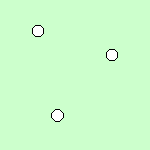 |
In this simulation, the square represents a pool of nutrients, and
each circle represents a cell. The pool nutrient density
is represented by different hues of green, with the darkest
the most dense.
With a small initial population of cells, pool nutrient density increases. But as the population of cells grows, nutrient density falls. Most of the cells die, as their idleness falls to zero. |
The cells that die during the population crash are the least idle of the varieties of cells, as these are the first to reach the zero idleness threshold. The idlest cells survive, and multiply to produce new variants, some of which are more idle, some less idle.
Cells may be able to increase idleness in various different ways, for example by becoming able to move from low energy environments to higher energy environments. Another way that cells may increase idleness, and hence the likelihood of surviving future crises, may be to form primitive multicellular entities. If, for example, cells have to perform a lot of repairs to surfaces exposed to a hostile environment, then total exposed surface area can be minimized if cells cluster together. The consequent reduction in maintenance work results in increased idleness for the cells in these clusters.
Once clustered together, the primitive multicellular then may find that idleness is increased if some cells restrict themselves to particular tasks. Cells near the surface would devote themselves to extracting energy from the environment, while internal cells would form structural members, or manufacture products useful to the community of cells. As this process continued, multicellular organisms would grow larger and more elaborate. In the search for nutrients, the ability of simple sensors to detect food allows creatures to move directly towards food, rather than search blindly, wastefully. The first eyes may simply have detected light and dark, and later different gradations of light, and colours. With each step in development, the owner of such eyes would become more discerning, able to negotiate obstructions, recognize shapes, distinguish different foods. At the same time, an ability to create an internal map of the local environment, a memory of where food is abundant and scarce, would save the chore of repeated exploration.
In the natural world, the first multicellulars are plants. When sufficient numbers of these exist, some entities find that living parasitically off plant energy stores offers a higher idleness alternative. These evolve into grazing animals. When sufficient grazers exist to provide a nutrient pool themselves, some grazers find that becoming predators increases their idleness.
The response of plants to grazers must be to construct defences - poisons, spines -, or multiply more rapidly. These defences, whatever form they take, impose extra costs on plants, and thus reduce plant idleness. To the extent that the defences are successful, grazers in turn have to work harder to acquire the energy stored in plants. So, as plants introduce defensive measures, and grazers take counter-measures, the idleness of both falls. And when predators hunt grazers, grazers in turn develop defences - armour, horns, high speed escape, camouflage -, which reduces grazer idleness, and predator idleness. If this falling idleness does not drive some species into exstinction, it will at very least reduce their chance of surviving any deterioration in the environment.
In this scheme, evolution is not a continuous process, but a slow, chugging cycle of design and test. At the end of each cycle, a new set of more efficient creatures emerges. But since the new creatures are more efficient than their predecessors, each crisis is deeper than the last one. Life has to jump hurdles which are getting steadily higher. One result of this is that while a particular lifeform may survive through several crises, eventually a crisis comes which it does not survive. Thus every form of life eventually faces extinction.
3. The Evolution of Human Society.
In Idle Theory, human life is regarded as simply another variety of natural life. Individual humans coalesce into human societies, in ways precisely analogous to the coalescing of individual cells into multicellular life. And the evolution of human society mirrors the evolution of preceding natural life. The basic problem for human life is the same as it is for all other life: how to survive.
In the scheme of evolution just outlined, life is easy and idle for long periods, and interspersed episodes of difficulty. It seems plausible to suppose that for long periods early human life was easy and idle, but interspersed with episodes when life became hard, and human idleness was driven downwards, forcing idleness-increasing innovation. Necessity (Latin, ne-cessare to not be idle) was the mother of invention. But human evolution did not entail modifications of human physiology so much as the development of social organisations, techniques, tools, and weapons. The history of human evolution is the history of the evolution of technology.
-
There seems to be no reason to suppose that humans always lived
in social groups. Rather, human society was itself an invention,
a mutual assurance society that offered its members increased likelihood
of finding food or capturing animals, as well as increased
protection against predators, and assistance when injured or sick.
-
The principal human innovation was the development of tools
- such as knives, bags, ropes, clothes, fire.
A knife enables plants or animals to be cut up more rapidly than they could
be torn apart with bare hands.
A bag enables a man to carry more than he can with his hands alone.
Clothes reduce body heat loss, and hence reduce food requirements.
Fire heated up the local environment, reducing body heat loss.
Fire could also be used to render food hot, quicker to eat and easier to digest.
Each of these tools brings increased idleness, and hence increased
likelihood of survival.
The production of a tool entails a time cost, which appears as a period of decreased idleness. Once made, and put to use, the time value of a tool is the increased idleness over its lifetime. If value exceeds cost, it is a useful tool. If cost exceeds value, it is a luxury.
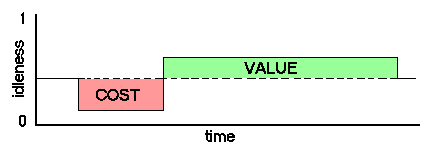
- The development of agriculture also increased idleness. Instead of
being gathered from the wild, plants were grown in one place, protected
from other grazing animals. This increased the yield, and reduced the
harvest time. And when herds of animals could be penned in one area,
they were easier to capture.
- Humans also set other animals to work for them. They used oxen to
draw wagons and ploughs, horses to ride, dogs to hunt. Getting these
various animals to work for them resulted in increased idleness for the humans,
but decreased idleness for the oxen, horses and dogs.
- In organised human society, rather than each individual making
every tool, each instead became a specialist in one trade. One made
knives. A second made bags. A third made clothes. The specialist
toolmaker could make a better tool in a shorter time and with fewer
resources than a non-specialist. So a society made up of specialist
craftsmen was more idle than one where everyone made everything.
- Also, within organized human society, there grew up a set of customs, or ethical codes of conduct, later formalised as laws. The effect of these laws was to make for smooth, harmonious operation of society with the minimum of dispute and contention, and thus to increase the idleness of society. Thus, for example, a convention as to who had right of way in a narrow passage would prevent time-wasting deadlock.
The idleness of a dependent system is the idleness of its least idle member, much as the strength of a chain is that of its weakest link. Thus as human society developed, it became important to ensure that idle time was equally distributed among its members. If it was not, and some were overworked, shortages of tools would appear, and these shortages would result in decreased social idleness, threatening the entire society. Egalitarian societies would survive crises which inegalitarian societies could not.
The primary human need is for idle time. This time need not be spent in complete inactivity. It can be used for games, pastimes, and the production of amusing luxuries. The time that can be devoted to these secondary wants is restricted by available idle time. If there is no idle time, there can be no games or luxuries. Thus there are two kinds of goods: primary tools which create idle time, and secondary luxuries which use up idle time.

The value of a tool such as a knife is the idle time it provides, which is an objective, measurable quantity. The value of a luxury, or toy, or game, is subjective and changeable. What one person likes, another may not. What one person enjoys one day, he may not the next. Needs can be distributed equally. Wants, of their nature, cannot.
The primary purpose of human society, and all its innovations and inventions, is to increase human idleness. This idleness is the fund of time that enables all art, music, literature, games, friendships, love affairs - everything that humans enjoy.
4. Human predators: conquest and empire
The success of human society in increasing its idleness resulted in a growing population, and the spread of farming settlements. But, assuming that the first settlements occupied the best land, new settlements would be forced onto poorer land, and a less idle existence. At the margin, life would be very hard, and such societies would urgently seek an easier existence. And just as increasing numbers of grazers prompted the appearance of predators, so wealthy human societies began to attract human predators, from the margins of civilisation, who robbed them or enslaved them or taxed them.
A tribe of nomadic hunters, in lean times, could turn their skill with spear and bow against rich but defenceless farming communities. It was either a hard life hunting animals, or an easy life robbing rich human settlements with their abundant stores of food. Once successful in this, the switch from hunting animals to pillaging farms became permanent. The idleness of the nomadic hunters increased. The idleness of farming communities fell, as losses to the new predators were made good, and defences constructed, militias trained.
Thus opened an era, in which the principal way for a society to increase idleness was through the subjection of other societies. Egalitarian human societies gave way to inegalitarian societies whose predatory rulers enjoyed a largely idle existence, and whose subjects were forcibly reduced to slave labour. The rulers interested themselves in the art of war. Their education stressed physical fitness, courage, endurance. Their ingenuity was devoted to the development of new weapons, new military tactics. Since their armies were made up exclusively of physically more powerful males, the role of women was reduced to providing the maximum supply of males to restock decimated armies. The rulers had little interest in the development of labour-saving technologies in farming and industry because their slaves performed this work for them. So technical innovation languished.
Since a larger army would usually defeat a smaller army, larger states subjugated smaller states, and expanded into empires.
This era resulted in a progressive fall in social idleness. Towns and cities became fortified, and garrisoned with militias. This in turn led to the development of siege warfare - catapults, scaling ladders, mines, battering rams. And that in turn led to the improvement of defences, with thick stone walls, moats, ramparts. All of which required increasing amounts of labour, and proportionally larger numbers of slaves. Falling idleness brought inflation, as the real cost of living increased.
While an empire expanded, it could enlarge the numbers of its aristocracy. Once it ceased to expand, or contracted, the numbers of idle rulers that the empire could support began to decrease. Increasingly, aristocrats were reduced to slavery. Civil wars within the aristocracy broke out as factions struggled for supremacy and security.
Ultimately, falling idleness brought the complete collapse of these coercive societies. The dwindling aristocracy became unable to impose its will, or to collect taxes and tributes. If the empires did not fall to external invaders, they disintegrated into a collection of independent smaller states, largely free of coercion. Freed from high taxation and the need for military defence, social idleness rose. Technical innovation to increase idleness, rather than improve weaponry, restarted.
In this way, and in other ways, human society has alternated between an easy, idle life and a life of toil and difficulty. Idleness increased as new techniques and technologies emerged, and decreased as populations rose and wars broke out.
| Value Systems | |
|
Low Idleness Society. In a low idleness society, where life is near-continuous toil at the brink of extinction, any mistake or omission threatens the existence of society. Therefore such societies must be highly disciplined, with each member carrying out their tasks with scrupulous care.
These are the ascetic practices of a monastery, and they are the required behaviour of humanity in extremis, and provide the baseline set of human survival values. In that fallen world, none would entertain any hope of a happy and carefree life. |
High Idleness Society Where social idleness increases, discipline can be relaxed. In the most idle society, the world is a playground.
Thus social values shift to reflect circumstances. What is right at one time becomes wrong in another. The discipline that serves so well in low idleness society is not an asset when life is a party. Equally the wit and humour and personal charm that are assets in idle society are of little account in low idleness society. |
5. European Civilizations.
In antiquity, when human technology developed slowly, the principal way for men to increase their idleness was by enslaving other men, and getting them to do their work. The Roman Empire was a vast system of coercion, extending across the entire Mediterranean basin, whose colonies were taxed to maintain Rome in idleness. After about 100 AD, the empire stopped expanding, and Roman power gradually dwindled until by 500 AD the Western Roman empire had been overrun by migrant tribes of Goths and Vandals, looking for new homelands.
After the collapse of the Western empire, Europe dissolved into a set of small feudal societies, whose peasant farmers paid taxes to local barons in exchange for protection from bandits and invaders. From about 500 AD to 1500 AD, new farming methods, ploughs, watermills, and other innovations appear to have raised social idleness. In the late medieval period, there were some 100 public holidays each year, in addition to the 52 sabbath days.
European innovation and invention produced technologies which surpassed those of other states. One likely reason for this is that in the cold north of the planet, life is much harder than in tropical regions, and idleness-increasing innovation is essential. Tropical humans, in Africa and America, living largely idle lives, had no need for such innovation.
Around 1500 AD, Western Christianity disintegrated, and began to be replaced by a secular humanism, which owed much to Greece and Rome. Emulating Rome, Europe began to use its technical superiority to forge a global empire. The Americas became colonies of Portugal and Spain. Africa was carved up. India became a British colony, as did Australia. When the expansion was nearly complete, and a few European nations controlled most of the world, European civil war shattered this hegemony. The empire broke up into small self-governing nations.
